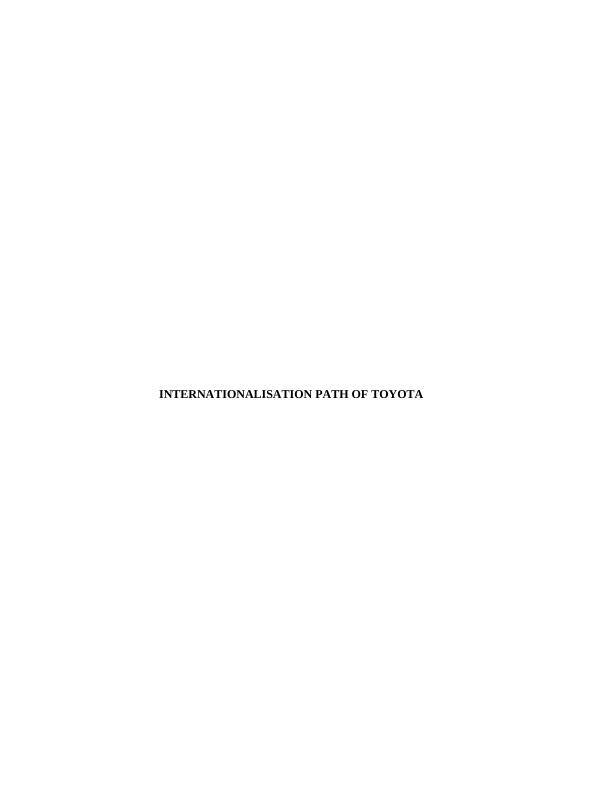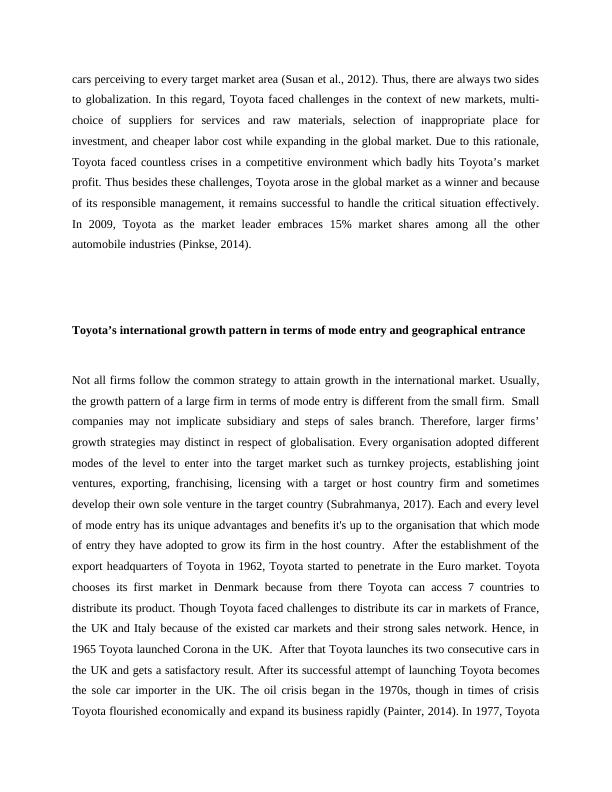Toyota International Strategy
11 Pages3109 Words598 Views
Added on 2021-04-27
Toyota International Strategy
Added on 2021-04-27
ShareRelated Documents
INTERNATIONALISATION PATH OF TOYOTA

Table of contents

Introduction Many Organisation adopt internationalisations strategy to sustain and achieve profitability.Organisation expands their business abroad by employing the benefit of large sale economics(Cohen, 2012). This essay evaluates the internationalisation path of Toyota which incorporatesthe international growth pattern of the company with respect to its geographical entrance andexamines the positive impact of the adopted internationalisation strategy on Toyota. Further, thestudy procedure includes the configuration changes in Toyota’s value chain activities. In last,this study explores the future potential risk that may be faced by the company. Discussion Toyota’s international growth and its motivation Toyota motor cooperation is a car manufacturing company headquarter is situated in Japan.Toyota comes into existence on August 28, 1937, and was founded by Kiichiro Toyoda.According to the 2017 report, its employee range becomes 364,445 further in 2019 it becomesthe tenth-largest company in the world by revenue (Balcet et al., 2012). Toyota was the firstautomobile manufacturing company that launch 10 million vehicles per year. Toyota leading inthe global market through its hybrid vehicles and hydrogen fuel cell vehicles. Further, Toyotasold approx. 7 million in the global market to more than 170 countries per year. In 2008, theglobal automobile market declared Toyota as the world’s largest automaker. Toyota hassuccessfully operated its business operation across the globe including United States, Africa,Russia, Australia, Pakistan, North America, etc. Toyota was launched SCION and Lexus inNorth America and the united states market (Manna et al., 2011). In recent years, Toyota mainlyfocuses to expands its market towards China because the propensity of Chinese consumptioncriteria changes. Toyota decided to expand its market in china because of this motivation thatchina is the second-largest economy in the world and this is the prime motive behindglobalisation. When a multinational corporation (MNC) operating its business and manages itsproduction in several other states but having its headquarter in the home country then it is knownas a transnational corporation(TNC) (Wood and Reynolds, 2014). The phenomenon behindToyota company is based upon a transnational corporation(TNC). Furthermore, the motivationbehind the international growth of the Toyota industry is skillful labours and employees. Toyotamotor cooperation is a key element of success is committed to engineering, designing, and build

cars perceiving to every target market area (Susan et al., 2012). Thus, there are always two sidesto globalization. In this regard, Toyota faced challenges in the context of new markets, multi-choice of suppliers for services and raw materials, selection of inappropriate place forinvestment, and cheaper labor cost while expanding in the global market. Due to this rationale,Toyota faced countless crises in a competitive environment which badly hits Toyota’s marketprofit. Thus besides these challenges, Toyota arose in the global market as a winner and becauseof its responsible management, it remains successful to handle the critical situation effectively.In 2009, Toyota as the market leader embraces 15% market shares among all the otherautomobile industries (Pinkse, 2014). Toyota’s international growth pattern in terms of mode entry and geographical entranceNot all firms follow the common strategy to attain growth in the international market. Usually,the growth pattern of a large firm in terms of mode entry is different from the small firm. Smallcompanies may not implicate subsidiary and steps of sales branch. Therefore, larger firms’growth strategies may distinct in respect of globalisation. Every organisation adopted differentmodes of the level to enter into the target market such as turnkey projects, establishing jointventures, exporting, franchising, licensing with a target or host country firm and sometimesdevelop their own sole venture in the target country (Subrahmanya, 2017). Each and every levelof mode entry has its unique advantages and benefits it's up to the organisation that which modeof entry they have adopted to grow its firm in the host country. After the establishment of theexport headquarters of Toyota in 1962, Toyota started to penetrate in the Euro market. Toyotachooses its first market in Denmark because from there Toyota can access 7 countries todistribute its product. Though Toyota faced challenges to distribute its car in markets of France,the UK and Italy because of the existed car markets and their strong sales network. Hence, in1965 Toyota launched Corona in the UK. After that Toyota launches its two consecutive cars inthe UK and gets a satisfactory result. After its successful attempt of launching Toyota becomesthe sole car importer in the UK. The oil crisis began in the 1970s, though in times of crisisToyota flourished economically and expand its business rapidly (Painter, 2014). In 1977, Toyota

End of preview
Want to access all the pages? Upload your documents or become a member.
Related Documents
Toyota Canada Supply Chain Risk Management (SCRM)lg...
|11
|2317
|209
Business Strategies of Toyota Motor Companylg...
|11
|3210
|124
Cross Industry Analysis of Toyota Corporation's Entry into Chinese Marketlg...
|13
|3633
|132
Case Study of Tesla Assignmentlg...
|10
|2718
|66
What Is a Business Project?- Typeslg...
|19
|6542
|20
General Motors presentation 2022lg...
|19
|705
|20
